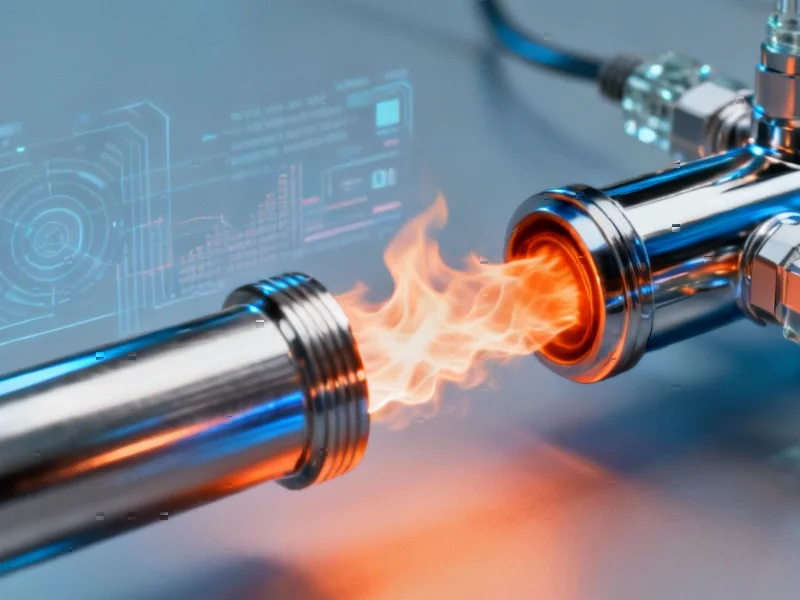Natural Gas Prices Surge as Market Dynamics Shift
While American consumers welcome falling gasoline prices, natural gas has emerged as a potential savior for US energy producers struggling with multi-year lows in oil markets, according to industry analysis. Sources indicate natural gas prices jumped 13% recently due to colder weather forecasts and structural market changes that are creating permanent price pressures.
Table of Contents
Market conditions continue to show significant volatility despite gas production remaining near record levels, analysts suggest. The increased sensitivity to weather patterns reflects new fundamental factors in the natural gas market that reportedly will drive prices higher long-term.
Export Growth and Infrastructure Constraints
The Energy Information Administration’s Short Term Energy Outlook Report forecasts substantial expansion in US liquified natural gas export capacity, according to reports. The analysis indicates 5 billion cubic feet per day in additional export capacity will come online by late 2026, representing nearly 5% of total US production.
This export growth could significantly tighten markets unless domestic production increases accordingly, the report states. However, production challenges loom as over one-third of US natural gas comes from oil wells, and with oil prices projected below the break-even point for new drilling, increased output appears difficult to achieve.
Regional Production Challenges
The Permian Basin, the world’s leading oil and gas producer, depends on higher oil prices to maintain viability, analysts suggest. If oil prices remain at projected lows, future growth will increasingly rely on natural gas, potentially sidelining the Permian’s output.
Meanwhile, the Appalachian region with its Marcellus and Utica basins is expected to play a crucial role in price stability. However, sources indicate current pipeline capacity may be insufficient to handle increased gas production, with some analysts projecting infrastructure could reach its limit this year.
Growing Demand from Multiple Sectors
Beyond weather-related consumption and export growth, new data centers across the United States are projected to add significant demand. Analysis suggests these facilities could require an additional 0.5 billion cubic feet per day annually, creating further upward pressure on prices.
This convergence of factors points toward rising natural gas prices long-term and corresponding increases in utility bills, not only for direct natural gas customers but for everyone purchasing electricity generated by natural gas, according to market observers.
Silver Lining for Energy Companies
The EIA reportedly projects natural gas prices could reach $4.00 by the end of 2026, though some analysts suggest actual prices might exceed that forecast. The current market situation creates an ironic dynamic where consumers benefit from lower gasoline prices due to oil oversupply while potentially facing higher natural gas costs.
Industry sources indicate the situation may provide US oil companies with opportunities to offset coming losses from declining oil prices with natural gas sales. This financial balancing act could potentially preserve industry jobs during the current downturn and ensure production capacity remains available when market conditions improve.
Related Articles You May Find Interesting
- Mobian Trixie Expands Debian’s Reach to Mobile Devices with Mainline Kernel Appr
- European Cybersecurity Strategy Shifts Toward Comprehensive Zero Trust Implement
- Samsung’s 2nm GAA Breakthrough Signals Major Shift in Global Foundry Race
- Anthropic launches Claude coding capabilities on the web
- Samsung Halts One UI 8 Rollout for Galaxy S23 Following Widespread Update Issues
References & Further Reading
This article draws from multiple authoritative sources. For more information, please consult:
- http://en.wikipedia.org/wiki/Natural_gas
- http://en.wikipedia.org/wiki/Natural_gas_prices
- http://en.wikipedia.org/wiki/Food_prices
- http://en.wikipedia.org/wiki/Price_of_oil
- http://en.wikipedia.org/wiki/Energy_Information_Administration
This article aggregates information from publicly available sources. All trademarks and copyrights belong to their respective owners.
Note: Featured image is for illustrative purposes only and does not represent any specific product, service, or entity mentioned in this article.



